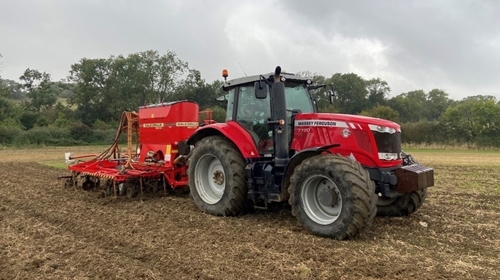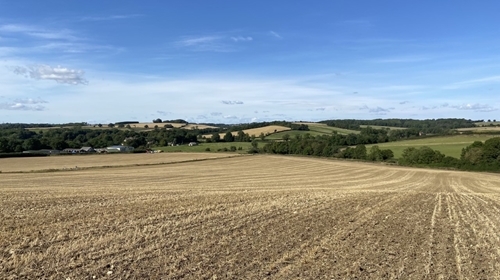
By Joe Stanley, Head of Training & Partnerships, The Allerton Project
This article first appeared in Countryside magazine
6 minute read
The crop drill has been busy here at Loddington, with farmers across the country relieved to experience a ‘normal’ autumn drilling season for the first time since 2018 – or at least a ten day window into which frenzied work has been committed! The key winter crops of barley and wheat have been successfully established in good soil conditions - the single biggest factor in the ultimate success of any crop.
A good start enabling the seeds to grow away strongly and put down decent root systems will make them more resilient and better able to thrive against whatever comes next. In recent years it’s been disheartening to have little choice but to drill into too-wet soil, or even fail to plant autumn crops at all due to unprecedented levels of rainfall which lasted until spring.
The drilling system at the Allerton Project is different to that which I have been used to. Previously, I would cultivate every field, either with plough or a set of deep disks, before planting into it with a power-harrow combination drill - effectively a second cultivator which thrashed the soil to work out any lumps before the trailing drill placed the seed. The aim was to create the finest seed bed possible with the least amount of surface residue from the previous crop.
This is a very traditional (and reliable) system widely practiced across the country, seeing fields post-harvest turned brown as farmers cultivate them ready for drilling - usually hoping for a ‘chit’ of weeds and seeds from the previous crop which will then be sprayed of with a herbicide to provide a ‘stale seedbed’ for the new seed.

For a decade the Allerton Project has been experimenting with reduced cultivation drilling, which at its purest will see the seed drill plant directly into the stubble and residue of the previous crop. The obvious benefit of this is the time and cost saved in forgoing the cultivation pass altogether, which on a farm the size of Loddington would take several weeks of labour and many hundreds if not thousands of litres of diesel. However, there are other benefits to this approach.
Reduced cultivation is a key element of ‘conservation agriculture’, whereby practitioners seek to reduce the amount of soil disturbance they generate in growing their crops. Reduced tillage and a greater volume of residue left on the soil surface from the previous crops (such as chopped straw and stubble) help to reduce erosion from wind and rain, thus safeguarding the farmer’s most valuable asset and reducing watercourse pollution by sediment and soil nutrients such as nitrates and phosphates.
Reduced tillage is also considered to be beneficial for soil structure, organic matter content, and the soil biome, all vital elements of soil health, a subject increasingly on the radar of British farmers.
Essentially, in the absence of cultivation, the soil structures itself (as it has done for countless millennia before the appearance of agriculture) through the interactions of soil organisms such as earthworms and the roots of the plants themselves, as well as assorted other soil micro-, meso- and macro fauna. In this undisturbed state, it then builds greater levels of organic content which in turn feeds the living soil ecosystem.
One teaspoon of healthy soil contains more living organisms than there are humans on the planet. Tillage disrupts this structure, oxidises much of the organic matter (releasing the associated carbon into the atmosphere) and reduces the soil biome, which is vital for the efficient cycling of soil nutrients.
Understanding of this process is, remarkably, relatively new to farmers in this country who, by dint of our general careful maintenance of our fields, mixed farming systems and generally benign weather, have not seen the sort of soil degradation that have forced those in some other parts of the world to adopt reduced tillage following experiences such as the ‘dustbowl’ of the American Midwest.
In fairness, scientific understanding of such soil processes is still very much a work in progress, so vast and complex is the soil ecosystem and its interaction with agriculture, but nevertheless the basics are generally now well understood and it’s a direction many farmers are increasingly moving in, with the retention and building of soil organic matter having a strong correlation with the ability of soils to sequester atmospheric carbon and act as a carbon sink – a farming solution to our warming climate.
Another key element of this system, also relatively new to me at Loddington, is the inclusion of ‘cover crops’ in the arable rotation. Instead of leaving fields fallow over winter before the planting of a spring crop, at Loddington we plant sacrificial mixes of these non-cash cover crops into our stubbles. These have various positive outcomes. Firstly, they provide the soil with a canopy to protect it from the heavy rains of winter to reduce erosion and nutrient loss.
Second, the mere fact of keeping ‘living roots’ in the soil – rather than leaving it bare – keeps the soil biome active and healthy and cycling the soil nutrients. Third, the cover crops assimilate loose nutrients in the soil which might otherwise be lost to ‘leaching’ over the winter; these nutrients are then available to the following spring crop when the covers are killed and incorporated back into the soil before the cash crop is sown.
Indeed, many cover crops include legumes which themselves ‘fix’ nitrogen (a vital nutrient) from the air, providing a natural source of this vital fertiliser and reducing the amount of expensive (potentially polluting) synthetic nitrogen we need to apply. Fourth, the incorporation of that leafy material helps build organic matter levels in the soil, building soil health and contributing to a virtuous, climate friendly cycle.
Some cover crops can also be grazed by livestock, not only giving the farmer a ‘second crop’ from an arable field in any one year, but also returning yet more valuable organic nutrition to the field in the form of manure.
I, like many, am essentially learning a whole new way of farming using what are now widely termed ‘regenerative’ techniques: reducing tillage; increasing the amount of organic matter in the soil; improving the diversity of my crop rotation; increasing soil biodiversity and reducing (though not removing) the use of synthetic inputs.
In many ways, this is not so much revolutionary as a return to many of the traditional farming practices of the pre-chemical age ushered in by the Second World War. But a huge amount of it is trial and error, with each farmer working out what is best for their individual farm, and it is certainly not without its challenges. In fact, we still find it necessary in some circumstances to use the plough; it’s important not to be too dogmatic in the real world of agriculture!
So as we head into the winter and towards Christmas (already!), the farm is looking in much better shape than in recent years. The cover crops are growing and the winter crops have been planted to give us hope for harvest 2022. I wish you and yours the happiest of Christmases in this December issue, and I hope you will join me for another view from the farm next month.